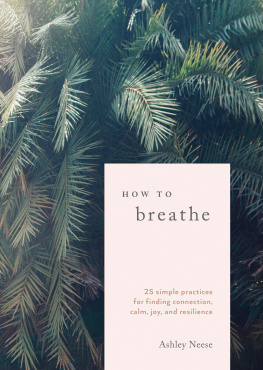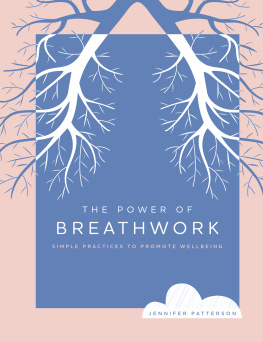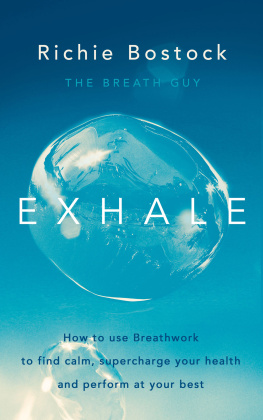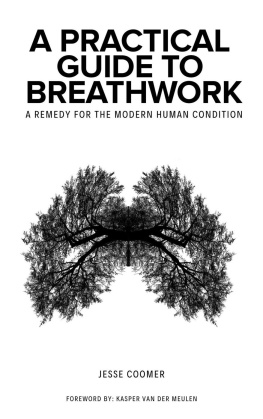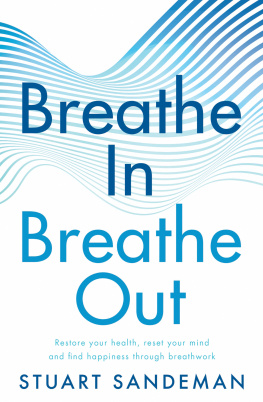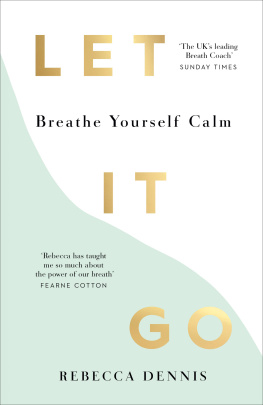Contents
Landmarks
Print Page List
ACKNOWLEDGMENTS
I am deeply grateful to those who made this lifelong dream come true and for those who supported me through this incredible, humbling journey. To my editor at Ten Speed Press, Kelly Snowden, who saw a space in the world for this book and helped refine the words to weave in the accessibility and depth that comes from these practices. To the incredible team that made How To Breathe come to life: Kara Plikaitis for her willingness to work with my distinct visual ideas; Emma Campion for taking a chance on this project; Jessica Comingore, who inspired the look and feel of this book; Erin Scott, whose dedication and unwavering encouragement for me to write this book made it possible; and Anas and Dax, who captured the tone and feeling of the imagery.
To my agent, Laura Lee Mattingly, who saw my vision, helped me refine it, and made this process seamless and fun. I am so grateful you believed in my work and my ability to write this book from the beginning.
Thank you to my parents, who recognized my creativity from an early age and fully supported my choices to carve out my own path. Thank you, Mom, for teaching me how to listen, set boundaries, and ask for more. Thank you, Dad, for reminding me that if I put my head down and work hard all that I dream of is possible. Thank you, brother, for showing me that life is so fragile and short and its how we live each moment that matters.
To my heart, Nic, for loving me and supporting all my visions, no matter how out there. Thank you for being willing to show up for the messy and sometimes painful experiences we sharenavigating what it means to be in conscious partnership. Thank you for taking care of yourself and thank you for stepping into this wild parenthood journey with me. To the golden child in my belly whom we cannot wait to meet, support, and love.
To the women who are my pillars, who are always keeping it real: Erica Chidi Cohen for showing me unconditional love and acceptance and for always getting me, even in moments when I dont fully get myself; Kelly LeVeque for showing me what generosity feels like and for always cheering me on; Trinity Troft for listening without judgment and reminding me how far Ive come; Lacy Phillips for encouraging me to take risks and reminding me I have the answers within; Megan Attore for showing up for all the things and being part of my family; Suzanne Hall for believing that my voice matters and encouraging me to follow my heart.
To my community of teachers and healers who supported every aspect of my internal processes and shaped the teacher I am today: Tony Giuliano, Amy Mitchell, Aileen LaPierre, Thea Nathan, Jason Handler, and Dave Berger. To my dedicated and inspiring clients, students, and journal readers who show up and do the work of going within.
Thank you to the lineage of women writers who came before me and didnt have the kinds of opportunities that I have been given to share my work. Thank you to my community of extended family and friends who have continued to show up and support my work in the world.
ASHLEY NEESE is a breathwork teacher and writer. Shehas studied with some of the worlds leading masters in yoga,meditation, medical intuition, and somatic therapy. Ashleydraws from this deep well of resources to guide people backinto their bodies where they learn how to cultivate resilience,develop relational intelligence, and trust the wisdom heldwithin. Her passion lives in the belief that our deepest andmost profound healing occurs when we learn to listen to theunique language of our bodies.
Ashley has been featured in magazines such as Elle Japan andthe Nourished Journal, and on websites such as goop, Vogue,Well+Good, MindBodyGreen, Jenni Kayne, and Byrdie,among others. She is in private practice in Los Angelesand the San Francisco Bay Area.
BREATH:
the Foundational Tool
Breath is the foundation for many healing arts practices, including meditation, yoga, and energetic medicine. Becoming curious about your breath is the quickest way to shift your emotions, thoughts, and vibration. In this section, I share the most essential things you need to know about breathing, the anatomy of breath, and how the breath and emotions are inextricably linked.
THE UNIVERSAL BREATH
At a very basic level breath is the foundation for life. A general rule of thumb is that humans can go for about three weeks without food, three days without water, and three minutes without oxygen. Not only is our breath essential to keeping us alive, it is also the key practice for modern-day wellness. It is beneficial to our overall health, resilience, and personal and collective growth.
Throughout history breath has often been associated with the concept of a life force or spirit. Interestingly, this connection is apparent in many corners of the world, across many cultures and disciplines. In Greek, the word psyche can be translated as life or breath. In Latin, the word spiritus means breath and is also where we derive the modern-day word spirit. The Sanskrit word pranayama comes from the words prana (life energy) and ayama (to extend, draw out). In classical Hatha yoga, pranayama is the practice of regulating the breath through techniques for specific health benefits.
There are tai chi breathing practices specifically designed to strengthen the diaphragm and acupuncture points in Chinese medicine to open the flow of qi (or life force) in the body. In some African and South American traditions, the breath is used to release spirits from the body, thus aiding in the healing of the individual and the community.
In addition to the rich historical landscape of the breath, we are learning today through neuroscience research that a number of nerve cells in the brain stem connect breathing to different states of mind. This research is significant because it confirms what thinkers, healers, and mystics have known for ages: we have the power to shift our thinking by changing the way we breathe. And since its already common knowledge that our thoughts affect our overall health, energy, and well-being, its safe to conclude that changing our breathing can have a global effect on our entire body.
A BASIC ANATOMY OF BREATHING
Our respiratory system is responsible for taking in oxygen and releasing carbon dioxide. Adults typically breathe twelve to twenty breaths per minute, which is about 20,000 cycles every 24 hours. This rate increases with physical exertion and decreases while in a resting state. Just to give you an idea of how the body uses oxygen, about 25 percent of it is used by the brain, while the kidneys use 12 percent and the heart just 7 percent. Our bodies need oxygen to sustain themselves and need to be able to expel carbon dioxide to cleanse the system. Breath is a natural detoxifier. When we think of cleansing these days, the go-to usually has something to do with the food we eat. And while that is essential for wellness, making sure we are breathing well throughout the day is an impactful way to keep our system clean and clear.
The major body parts and organs that are involved with breathing are the mouth, nose, larynx (voice box), trachea, lungs, and diaphragm. When we breathe, oxygen enters the nose or mouth. The air moves through the pharynx (throat), larynx, and trachea into the lungs. Then air is exhaled, flowing back through the same pathway. One of the reasons I encourage my clients to breathe through their nose (when they are not engaged in strenuous exercise) is because inhaling through the nose enhances endurance and increases our ability to focus. The nose is also a defense against bacteria and produces nitric oxide, which is a very important compound for cardiovascular, immune, and sexual health.

